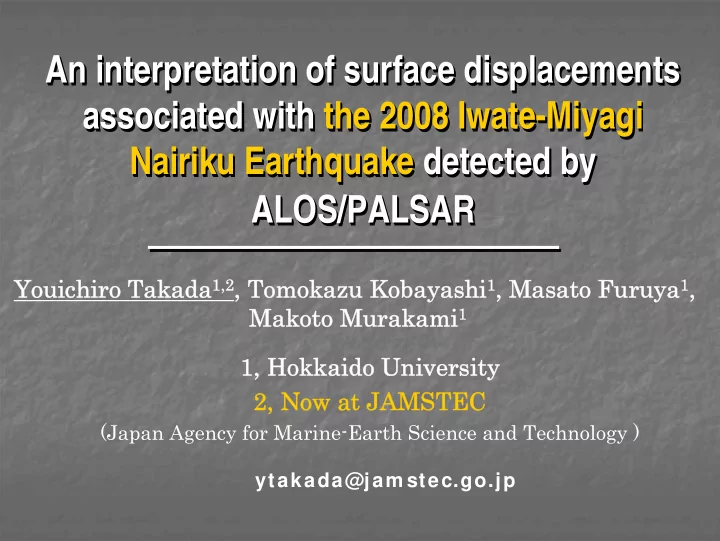

An interpretation of surface displacements An interpretation of surface displacements An interpretation of surface displacements associated with the 2008 Iwate the 2008 Iwate- -Miyagi Miyagi associated with associated with the 2008 Iwate-Miyagi Nairiku Earthquake detected by detected by Nairiku Earthquake Nairiku Earthquake detected by ALOS/PALSAR ALOS/PALSAR ALOS/PALSAR Youichiro Takada 1,2 Youichiro Takada 1,2 , Tomokazu , Tomokazu Kobayashi Kobayashi 1 , Masato Furuya , Masato Furuya 1 , , Makoto Murakami Makoto Murakami 1 1, Hokkaido University 1, Hokkaido University 2, Now at JAMSTEC 2, Now at JAMSTEC (Japan Agency for Marine-Earth Science and Technology ) ytakada@jam stec.go.jp
2008 Iwate-Miyagi Nairiku Earthquake Mechanism WNW ー ESE Compression USGS: Mw 6.9 13 June 2008 23:42:46 UTC (14 June JST)
ALOS/PALSAR Data Acquisition Path 57 Path402
InSAR InSAR Atmospheric effect. 6cm or more Left:Ascending Path402 (760-780) 2007/06/21 (FBD) 2008/06/23 (FBS) Bperp=-330m Right:Descending Path57 (2820-2840) 2007/08/29 (FBS) 2008/06/23 (FBS) Bperp=-774m Clear fringes. Coherence loss in epicentral area. Δ LOS LOS Processed with Gamma & GSI 50m DEM
For the 2008 Iwate-Miyagi Nairiku EQ., Is single fault model good approximation? No. Is there any known active fault? Only around the northern edge. Is forward modeling wrong? No, absolutely not.
Distance (km) ? ? Depth (km) Seismicity (JMA) (JMA) Complex Geometry with Seismicity Conjugate Faulting
Fault modeling Fault modeling Forward modeling by Okada (1992) → Modifying fault parameters (Trial & Error, & Grid Search) rectangular shape 、 uniform slip Preferred Model Latitude, Longitude, Length, Width, Depth, Dip, Strike, Slip angle, Slip(m), Mw F1: 140.90 39.12 9.0 5.0 4.0 27.0 190 80 1.5 6.1 F2: 140.895 39.04 8.5 6.8 2.3 37.5 180 76 3.0 6.4 F3: 140.85 38.99 10.0 6.5 2.6 53.0 355 71 2.1 6.3 F4: 140.854 38.94 10.2 6.5 2.2 30.0 200 62 6.4 6.7 F5: 140.79 38.85 7.5 3.0 2.3 55.0 200 80 2.0 6.0 Conjugate ESE dip: F3 Faulting WNW dip: F1,F2,F4,F5
Observed Synthetic Residual Asc. Dsc. Δ LOS [cm] Residual [cm] F3 dips to east Residual < 6cm in most area
Consistency with Range Offsets Range offsets [m] Takada et al.2009
NIED F-net June 14-20 Moment solutions (Velocity given by JMA) http://www.hinet.bosai.go.jp/ topics/iwate-miyagi080614/ Mt.Kurikoma Strike Slip is dominant!! ↓ East dipping fault is not very long.
Newly found this year. Valley side Hill side Never landslide!
Left lateral motion Bamboo grass is draged
Range offset (Dsc) With 10m DEM Photos SAR image is never illusion. Non-elastic surface material results in complex displacement. Kurikoma
Bouguer Gravity Anomaly ★ Very complex crustal structure due to calderas!! Komazawa et al.(2004) 2.67g/cm 3 grid data Imaizumi and Nakata (2002) Active fault data
Pixel Offset and Bouguer Anomaly Ascending Descending Uplifted area matches Bouguer high. Large gradient in Bouguer anomaly → displacement discontinuity
Map of buried calderas in the NE Japan After Yoshida (2001) Many calderas in the NE Japan would cause very complex crustal deformation. Sanzugawa-caldera Beneath KRK Onikobe Caldera
Sum m ary Sum m ary Sum m ary � At least five faults are required to account for the 2008 At least five faults are required to account for the 2008 � Iwate- -Miyagi Nairiku Earthquake. Miyagi Nairiku Earthquake. Precisely determined Precisely determined Iwate hypocenter data are consistent with our fault model, but hypocenter data are consistent with our fault model, but further improvements are possible. further improvements are possible. � Uplifted area fits Uplifted area fits Bouguer Bouguer high, and notable displacement high, and notable displacement � discontinuity occurred along large gradients in the anomaly. discontinuity occurred along large gradients in the anomaly. Complexities in the SAR data results from buried calderas. Complexities in the SAR data results from buried calderas. � Pixel offset analysis was confirmed by the field survey. Pixel offset analysis was confirmed by the field survey. � Very complex displacements in the epicentral epicentral area is due to area is due to Very complex displacements in the non- -elastic responses of weak surface materials. elastic responses of weak surface materials. non Acknowledgement: This study is supported by grant in aid for scientific research B (19340123). PALSAR level 1.0 data were provided from the PALSAR Interferometry Consortium to Study our Evolving Land surface (PIXEL) and Earthquake Working Group under a cooperative research contract with JAXA. The ownership of PALSAR data belongs to METI and JAXA. Hypocenter data are provided by JMA and GIMNE. The mechanical solutions are provided by NIED. The 50m DEM is provided by GSI. The 10m DEM is made using the 1/25,000 scale topographical map provided by GSI, Ministry of Land, Infrastructure and Transport. (Approval No. Hei 20 Gyoshi, No.203-24663). We thank Drs. S. Toda, T.Maruyama, and R. Ando for allowing us to use photographs.
END END END
Recommend
More recommend